Acer Predator Z1 Review: Behind the Curve?
The Acer Predator Z1 offers a crisp, curved 27-inch display and some neat extras, but it has a high asking price for a 1080p monitor.
Why you can trust Tom's Guide
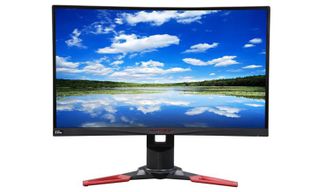
The 27-inch Acer Predator Z1 occupies a curious middle ground in the world of gaming monitors. It's curved, but compact. It has a high-end look and feel (and price), but it outputs at 1080p instead of 4K. The $599 Z1 has some neat lighting, makes most games look great and offers G-Sync for extra-smooth graphics. But considering you can get a 4K display for its price, you'll have to seriously consider just how much a curved screen means to you.
Design
When I think of curved gaming monitors, I normally picture massive pieces of machinery that engulf my entire desk. That's why I was so stunned by our 27-inch version of the Predator Z1, which makes a huge impression within a relatively compact frame.
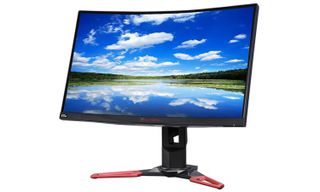
As with any Acer product that bears the Predator name, the Z1's red-and-black design is distinctly aggressive. The monitor's curvy display sports a hard-to-miss Predator logo on its bottom bezel and is supported by a sturdy metal base with large, menacing legs. The Z1 is a breeze to adjust; you can tilt the display 25 degrees back or 5 degrees forward, or swivel it 30 degrees to the left or right. You can also raise or lower the screen up to about 5 inches, whether you want to prop it high up or have it practically touch your desk.
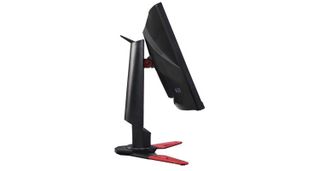
You may not notice them at first, but the Predator's bottom-facing LED lights are the real kicker. You can set the lights to glow an assortment of colors — including red, blue and green — and choose whether they glow statically, pulsate in and or ripple side to side.
But my absolute favorite feature is the lights' ability to mimic whatever color is on your screen; whether it was the whites of Google Docs or the deep blues of my Windows wallpaper, the Predator's LEDs synced up with the display perfectly. The Predator's lighting is a great touch that you just don't see on many gaming monitors, and adds some extra illumination to whatever colorful keyboard and mouse you're probably already using with your gaming PC.
MORE: The Best Gaming Desktops Available Now
Ports and Interface
The Z1 keeps things basic on the connections front, offering an HDMI port, a DisplayPort and a headphone jack in the rear. Once all of your wires are plugged in, you can pop an easy-to-attach panel to the backside that hides any cord clutter.
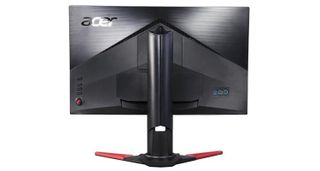
Just behind the Z1's left edge are four USB 3.0 ports and a USB Type-B port, which make it easy to plug in any accessories that your PC doesn't have room for. I would have liked the headphone jack to be just as reachable, but it's not a huge annoyance.

Gaming monitor interfaces run the gamut from intuitive to painfully hard to navigate, and I was pleased to find that the Z1 falls into the former camp. You'll do most of your navigation using a small, red nub behind the display's right edge, which is complemented by three click buttons. You can use the three buttons to quickly toggle key features (such as display mode, brightness and input) or press the nub in to open a full menu and tweak every possible setting.

Using the Z1's nub felt much more natural and intuitive than dealing with many of the capacitive and button-based interfaces on other monitors. There were rare instances in which the nub got a bit stuck, but it was never enough to keep me from making quick adjustments on the fly.
Gaming Performance
The Predator Z1's 27-inch, 1080p screen handled just about every genre well, starting with the cinematic action of Rise of the Tomb Raider. The screen made it easy to spot individual speckles of snow in Lara Croft's hair, and everything from the red of her winter jacket to the orange of explosions had a nice pop to it on the monitor's Standard mode. (I found the screen's Action mode a bit too dark and saturated, but I'll explain more on that later.)
My absolute favorite feature is that the monitor's lights mimic whatever color is on your screen.
Acer's display made an excellent showpiece for Star Wars Battlefront, preserving the gorgeous deep blues and snowy skies of a nighttime starfighter battle on Hoth as well as the crisp oranges and dark greens of a fiery, battle-ravaged Endor.
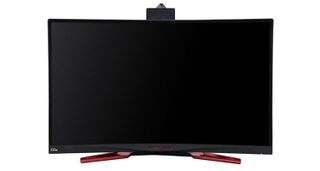
Curved monitors are a natural fit for racing games, and the off-road action of Dirt 3 looked sharp and played wonderfully on the Z1. While Acer's wider, higher-end Predator X34 did a better job of getting me immersed in the action (particularly when I was controlling cars or spaceships), the Z1 was impressively engrossing given its relative small size.
A gorgeous monitor is useless if it's laggy, and I was pleased with how responsive the Z1 was. The display never kept me from pulling off my usual combos in Street Fighter V, even the ones that required frame-perfect timing.
G-Sync Performance
As with most Predator monitors, the Z1 supports Nvidia G-Sync, which aims to eliminate screen tearing and stuttering by syncing your screen directly with your Nvidia graphics card. G-Sync worked just as advertised in my testing, allowing me to play Batman: Arkham Knight at as high as 90 frames per second without experiencing any tears. Impressively, the game ran almost as well with G-Sync off.
Acer's display made an excellent Star Wars Battlefront showpiece, preserving the gorgeous deep blues and snowy skies of a nighttime starfighter battle on Hoth.
Brightness and Color
The Z1 is one of the brightest monitors we've tested, notching an impressive 293 nits on our lab test. That tops BenQ's XL2420G (173 nits) as well as our 229-nit average.
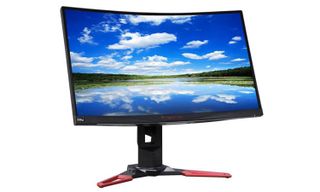
Acer's monitor proved similarly strong in our color tests, turning in a Delta-E accuracy rating of 1.39 (closer to 0 is better) while reproducing 117 percent of the sRGB color gamut. That beats the BenQ by a landslide (10.45 Delta-E, 103 percent of the color gamut), and tops our averages for both accuracy and gamut.
MORE: Our Favorite Gaming Keyboards
Modes and Features
The Z1 offers eight display modes that you can access and switch among with a few easy clicks. There are game-specific presets: Action mode is dark and saturated and provides a crosshair overlay by default, while the less-distinct Racing and Sports modes look a bit darker and duller than default settings.
There are also presets for graphic design, movies and an energy-saving Eco mode, as well as a neutral Standard mode (which I stuck with most of the time).
The Z1 allows you to activate one of three crosshair overlays that are designed to give you an edge in shooting games. I'm not sure if they made me play any better, but when I played Rise of the Tomb Raider and Star Wars Battlefront, the overlays synced up perfectly with the in-game reticles.
The Z1 allows you to activate one of three crosshair overlays designed to give you an edge in shooting games.
Other than that, the Z1's feature set is pretty standard. There's a blue-light-reduction option for reducing eyestrain, as well as a dark boost setting for highlighting dark in-game areas. You're free to tweak things like brightness, color saturation and gamma until you've found your perfect mix.
Audio
I usually forgo built-in monitor audio in favor of a good pair of headphones, but the Z1's speakers are impressively loud and crisp. The monitor filled our 15 x 15-foot testing lab with the sounds of Star Wars Battlefront, allowing me to hear everything from the game's iconic blaster noises to thunderous thermal detonator explosions in high detail.
Bottom Line
There's a lot to like about the Acer Predator Z1. It looks cool, it's responsive and it will make just about all of your games look gorgeous at 1080p. Its highly adjustable stand makes it a breeze to tweak it to your liking, and extra features such as crosshair overlays and dynamic LED lights are nice touches.

However, given the Z1's relatively low resolution and small size, you might be better off getting a 4K monitor for the same price. For example, ViewSonic's XG-2700 offers ultra HD for less than $500. The Predator Z1 isn't a bad buy if you insist on getting a curved screen at a decent price, but you should consider your alternatives first.
Sign up to get the BEST of Tom’s Guide direct to your inbox.
Upgrade your life with a daily dose of the biggest tech news, lifestyle hacks and our curated analysis. Be the first to know about cutting-edge gadgets and the hottest deals.
Mike Andronico is Senior Writer at CNNUnderscored. He was formerly Managing Editor at Tom's Guide, where he wrote extensively on gaming, as well as running the show on the news front. When not at work, you can usually catch him playing Street Fighter, devouring Twitch streams and trying to convince people that Hawkeye is the best Avenger.

